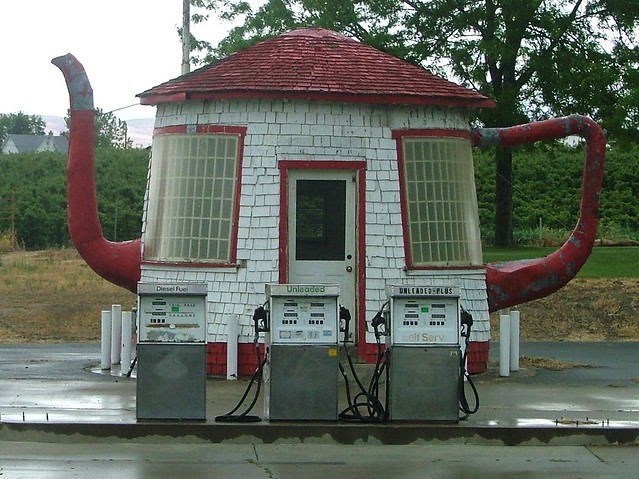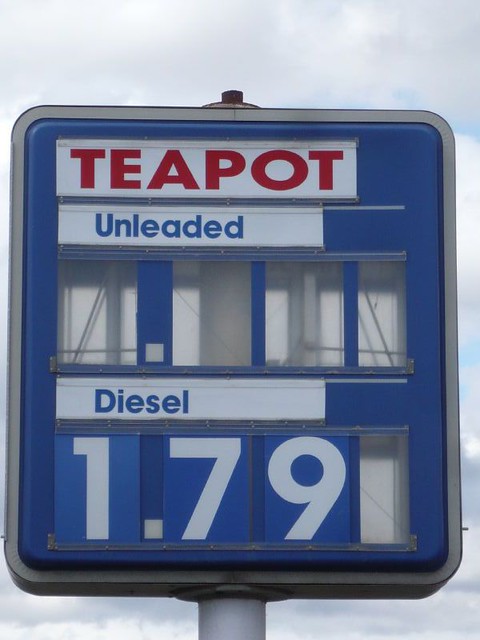Political cartoon relating to the "Teapot Dome" scandal in the early 1920s, which involved feder. . . .
1. http://tpscongress.indiana.edu/public-eye/gallery/looks-out-for-itself/
National Register of Historic Places

Teapot Rock (Dome)
Natrona CountyDate Added to Register
Monday, December 30, 1974Smithsonian Number
48NA213Read all about it
Teapot Dome is an historic site of national significance over which developed a scandal of national proportions, involving California as well as Wyoming oil fields and involving high officials of the United States government and private enterprise. However, the dome itself is less visible than the rock for which it was named. Therefore, the nomination to the National Register of Historic Places pertains to the rock which is a visible symbol or reminder of that famous American scandal. Teapot Rock is an eroded sandstone formation located about 25 miles north of the city of Casper in the southwestern Powder River Basin. The formation which once looked like a teapot has given its name to a number of natural and man-made features of the surrounding landscape including a creek, townsite, oil development company, and one of the most famous oil fields in American history. About six miles east of the rock is the southern boundary of the Teapot Dome Naval Oil Reserve; 9,481 acres of land set aside in 1915 by presidential executive order as United States Naval Oil Reserve Number Three.Front pages of The Oklahoman's coverage of the trial on March 12, March 13 and March 16, 1921. The Oklahoman Archives. . . . . oh don't worry print news is gone now. Teapot Dome assets selling to highest bidders |
Teapot Dome: How a Presidential Scandal Led to a Teapot-Shaped Service Station
The Teapot Dome scandal of 1922-23 tarnished an entire US presidency and resulted in the first instance of a US Cabinet member being sent to prison for actions committed in office. It also resulted in the construction of an incredibly unique service station in the middle of the state of Washington that became a rather offbeat tourist attraction. How, then, did this Wyoming rock formation:

…lead to this kitschy Washington roadside attraction, and what did it have to do with the US presidency?
Source: L. Myhre, http://www.flickr.com/photos/larrymyhre/4680650672/. Licensed under the Creative CommonsAttribution-NonCommercial-ShareAlike 2.0 Generic licence.
It all stems back to the short-lived presidency of Ohio’s Warren G. Harding, which occurred during a time after World War I when industry was rapidly switching from coal power to petroleum power, creating a large oil boom across the American west. A previous president, William Howard Taft, had established a system of oil reserves in California and Wyoming, of which three were ultimately set aside to supply the US Navy with oil. The reserves were located at Elk Falls, California; Buena Vista Hills, California; and Teapot Dome, Wyoming.

Teapot Rock atop Teapot Dome, Wyoming. The oil field itself is located to the top right. Source: Wvbailey,http://commons.wikimedia.org/wiki/File:Teapot_WY_1.jpg. Licensed under the Creative Commons Attribution-Share Alike 3.0 Unported licence.
Taking office in January 1921, Harding was very keen on rewarding his friends and allies with powerful political positions, many of them rather financially lucrative (this network of associates would become known as the Ohio Gang as many of them had been in Harding’s circle since his days as a state politician). One of these men was Albert B. Fall, who Harding named as Secretary of the Interior. When Harding took office, he removed the naval petroleum reserves from naval control and placed them under Fall’s jurisdiction. It just so happened that Fall was friends with oil barons Harry F. Sinclair (he of Sinclair Oil fame) and Edward L. Doheny (the man who set off the first petroleum boom in Southern California). Fall promptly leased a portion of one of the Californian naval reserves to Doheny, and then in April 1922 leased the entire Teapot Dome reserve (3 837 ha, or 9 481 acres) to Sinclair. Fall would secretly pocket about US$504 000 (around US$6.56million today) in cash, loans, and gifts from Doheny and Sinclair for brokering the deal.
When Wyoming senator John Kendrick learned of the deal after one of his constituents (a small oil operator) complained, Kendrick requested an investigation on the Senate floor. During the investigation, records kept disappearing, and while Fall was able to hide most of the money in his cattle ranch, he forgot to cover up a $100 000 loan from Doheny. When this became public, it sent a shockwave through American politics that would resound for some time. The US Supreme Court would rule in 1927 that the naval oil reserves were obtained fraudulently and returned them to the Navy. Today, Teapot Dome is still owned by the Department of Energy.
Fall was fined US$100 000 and sentenced to a year in prison, the first US Cabinet member to be jailed for actions committed in office. Sinclair would be indicted for conspiracy to defraud the United States in October 1927, but the trial would be halted two weeks later when it was discovered Sinclair had hired a detective agency to shadow the jury. Sinclair was found guilty of criminal contempt of court spent six months in prison. Doheny, meanwhile, managed to be acquitted (yes, Fall was convicted for accepting an illegal bribe, but Doheny was found not guilty for issuing the bribe) and would actually go on to foreclose on Fall’s New Mexico once Fall no longer had the fund to pay him back. Other members of the Ohio Gang were also convicted for various other instances of bribery and fraud that occurred during the Harding presidency and sent to prison; some even committed suicide. Exhausted from scandal and not in the greatest health to begin with, Harding himself would not see the end of the trial nor even survive 1923, dying of a heart attack in San Francisco while on a tour of the western States. At two days short of 29 months, his was the shortest tenure of any US head of state of the 20th century.
Fortunately, the rest of the story is much lighter in tone. During the height of the scandal, a businessman in the burg of Zillah, Washington by the name of Jack Armstrong decided to capitalise on the Teapot Dome scandal that was rocking the nation during 1922 by hand-crafting a new filling station in the shape of a teapot next to his family’s general store. The Jacobs family bought the station six years later and operated it for many years, where it became a popular stop along US Route 12 for decades.
The Teapot Dome has been relocated twice. In 1978 the Interstate 82 highway was built through the Yakima Valley overtop of the lot where the station stood, forcing the owners to move. The giant teapot was disassembled piece-by-piece and reconstructed a short distance down the road away from the new road. At some point, it became known as the oldest continually operating gas station in the United States before, having been bypassed by the big new freeway,closing up shop in the 1980s.
The Teapot’s gas price sign, frozen in time at about US$1.20 cheaper than prices in the area were at the time this article was published in January 2013. Source: T. Lipper, http://www.flickr.com/photos/wafflechomper/2406733840/. Licensed under the Creative Commons Attribution-NonCommercial-ShareAlike 2.0 Generic licence.
A 2007 photo shows the window in the Teapot’s door vandalised. Source: G. Kingston,http://www.flickr.com/photos/kathrine/539968157/. Licensed under the Creative Commons Attribution-NonCommercial-ShareAlike 2.0 Generic licence.
Despite its historic status (both the original Teapot Dome and its service station namesake are listed on the National Register of Historic Places), the Teapot Dome Service Station was left to flounder for years and fell into grave disrepair before the city of Zillah stepped in to save the station in 2007. Through fundraising, grants, and a loan, the city moved the building to a new location at the west entrance to Zillah and refurbished the teapot completely. In 2012, the Teapot Dome was reborn as Zillah’s tourist information centre, and (non-working) vintage gas pumps were reinstalled.
The Teapot Dome is hardly the only quirky building in Zillah. When a church affiliated to the Church of God opened in the city in 1987, it was quickly realised that the ‘Church of God, Zillah’ would be a rather punderful appellation. As such, while the church is officially named the Christian Worship Center, locals have always referred to it as the Church of God-Zillah, and the denomination decided to embrace it, erecting a wire-frame replica of Godzilla clutching a cross while holding a sign proclaiming ‘Jesus Saves’in the church’s parking lot.
While there may not be another teapot-shaped filling station anywhere else, there are all sorts of unique and kitschy stations out there. I’ve compiled even more gas station wackiness in my latest Google Sightseeing post.
Further Reading
Baskas, H. (2012). Teapot Dome Gas Station has a new home. Stuck At the Airport, 22 April 2012. Available athttp://stuckattheairport.com/2012/04/22/teapot-dome-gas-station-has-a-new-home/. Accessed 23 January 2013.
City of Zillah (2007). Teapot. Available at http://www.cityofzillah.us/Teapot.html. Accessed 23 January 2013.
Earls, S. (2000). Church of God-Zillah. Yakima Herald-Republic, 10 June 2000. Available athttp://community.seattletimes.nwsource.com/archive/?date=20000610&slug;=4025861. Accessed 23 January 2013.
Simkin, J. (n.d.). Harry F. Sinclair. Spartacus Editorial. Available athttp://www.spartacus.schoolnet.co.uk/USAsinclairHF.htm. Accessed 23 January 2013.
Washington State Department of Archaeology & Historic Preservation (2012). Zillah Celebrates Teapot Dome Move & Rehab. 16 July 2012. Available at http://www.dahp.wa.gov/blog/2012/07/zillah-celebrates-teapot-dome-move-rehab/. Accessed 23 January 2013.
Wyoming State Historic Preservation Office (2013). National Register of Historic Places: Teapot Rock (Dome). Available at http://wyoshpo.state.wy.us/NationalRegister/Site.aspx?ID=297. Accessed 23 January 2013.





